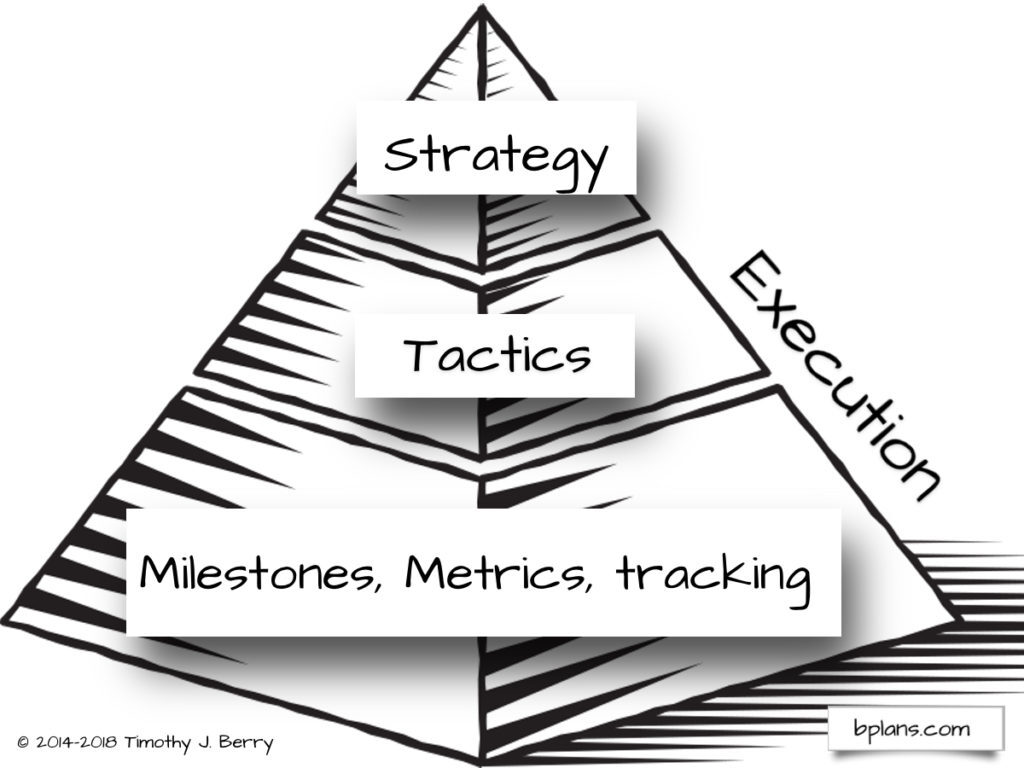Set Tactics to Execute Strategy
Jump to

It happens all the time. You take your team away from the routine for a few hours, brainstorm, and develop a brilliant new strategy for your business. And when you all get back into the routine, the routine wins and strategy loses. Nothing changes.
The plan was brilliant on the whiteboard but never got to the real world. What happened?
Tactics are the measurable action steps toward a larger strategic goal
Your business strategy is useless without execution. Don’t leave that whiteboard without developing key tactics. Make sure the execution tactics you choose are directly in service of your strategic goal. For every action you take, you should be able to say how it relates to your overall business strategy.
I use the image of the pyramid below to explain strategy, tactics, and execution.

Strategy is at the top of a pyramid. Strategy is focus. It’s a collection of choices that narrow your aim to target markets and with product or service offerings that match both the target market and your own identity. Strategy is, therefore, deciding what you are not doing; like who isn’t in your market and what products you aren’t going to offer. Tactics make up the second level of the pyramid. They are more specific and practical decisions taken to execute the strategy. For example, choosing to target the high-end less price sensitive market segment is strategy. Pricing is tactic. Choice of channels and marketing messages are tactics. Concrete specifics, milestones, budgets, tasks, responsibility assignments, tracking, and following up make up the third level, at the bottom of the pyramid. They have to be defined in detail and they should also be measurable. Execution is a good word for both of the lower two levels of the pyramid, taken together. Execution includes the tactics and the concrete specifics.
For example, in How to Develop Your Business Strategy on Bplans, I used a bicycle store as an example of how strategy leads logically to execution. Let’s start with strategy:
Imagine the difference between a bicycle retail store owned and operated by a former professional bike racer, and another one owned and operated by a couple with children who like bicycles as a family activity.
The first one will probably stock and sell expensive, sophisticated bicycles for the racing enthusiast and extreme long-distance or mountain biking hobbyist. The second will probably emphasize bicycles for children, bike trailers, carriers, and accessories for families.
Whichever direction the bike store takes is strategy, and it won’t work without execution, the tactics. In this case, the tactics would include what to stock in the store and what not to stock, general pricing level, promotions, bundles, participation in local events, tone and content of social media, advertising messages and media, even how to position service. And, aside from the tactics, it takes concrete specifics such as milestones (dates and deadlines) and budgets.
Execution should be strategically aligned with your goals
I’m amazed that so much of what I see written about business plans includes strategy but skips execution. In truth, the tactics are usually there, broken into sections such as the marketing plan, product plan, financial plan, and management plan. And the better business plans also include the concrete specifics, presented as major milestones, metrics, dates, budgets, and so forth. Alignment means the tactics match the strategy and the concrete specifics match the tactics.
So, the good news is that we actually do think through tactics and include them in the plan but the bad news is we don’t always articulate the relationships between the strategy and the tactics. And we don’t always add in the specifics. We lose strategic alignment, which is the coordination between your plan and execution.
What’s strategic alignment? It’s the right hand knowing—and working with—what the left hand is doing. So if the bike store owner says her business strategy is to focus on the family market, then she shouldn’t stock fancy bikes, she can’t charge upscale pricing, she can’t advertise in the extreme sports or extreme fitness websites. Her social media content is about kids and family, not racing. She takes her store to local activities like charity bike rides and school parades, not triathlons.
Lack of alignment happens way too often. I spent years consulting with Apple Computers helping dealers counter the so-called “box pushers” in big-box stores by focusing on small business and really good service.
“Strategy without execution is the slowest route to victory, and tactics without strategy is the noise before defeat.”
– Sun Tzu from “The Art of War”
However, way too often, they’d claim that as strategy in meetings but still offer only mediocre service.
The good ones remodeled their stores to add a big service counter and put employees in white coats behind the counter. And they bundled installation into sales and added white vans plastered with “another installation” banners on the side.
Strategy, tactics, and concrete specifics: The planning pyramid
So as you do your plan, think of a pyramid in which strategy is at the top, tactics in the middle, and concrete specifics including milestones, tasks, budgets, and performance metrics at the bottom.
Make sure your pyramid points line up. If you are doing a Lean Plan, leave strategy and tactics as bullet points. If you are doing a formal plan, break the tactics up into marketing, product, financial, management, and other.
Do your thinking first, for your own use; then do whatever you need to meet the requirements of the formal plan for readers outside of your own team.
This article was originally published on Bplans.
More in Planning

planning
Use This Simple Business Plan Outline Example to Organize Your Plan

planning
How to Write a Small Restaurant Business Plan + Free Sample Plan PDF

planning
How to Write a Trucking Business Plan + Example Templates

planning






